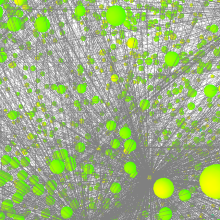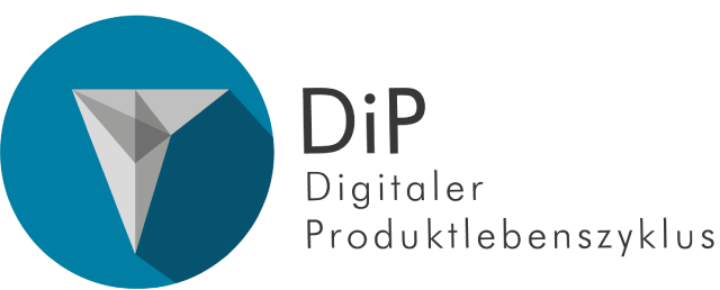Graphenbasierte Entwurfssprachen zur Entwurfsautomatisierung
Graphenbasierte Entwurfssprachen bilden Begriffe (d.h. das "Vokabular") und Zusammenbauwissen (d.h. die "Regeln") in rekombinierbaren Sprachbausteinen und Operationen ab. In der Informationsdarstellung einer Entwurfssprache dienen die Knoten eines Graphen als abstrakte Platzhalter (d.h. als Modelle) für reale Objekte oder Prozesse. Somit wird anstelle des Produktdesigns eine grafische Darstellung ("Entwurfsgraph") maschinell verarbeitet. Diese maschinelle Verarbeitung erweitert und modifiziert den Graphen zur Laufzeit dynamisch durch sogenannte "Model-to-Model-Transformationen" (M2M). Die abstrakte Produktdarstellung ermöglicht eine einfache Modularisierung und Skalierbarkeit und ermöglicht die konsequente Integration verschiedener disziplinärer Domänenmodelle (siehe Abbildung unten). Die Kopplung des Frameworks an domänenspezifische Softwaresysteme ist unerlässlich, um das vorhandene Wissen und die Teilprozesse zu integrieren. Die Kopplungen sind als Schnittstellen implementiert, die aus der abstrakten Diagrammdarstellung ("model-to-text transformations" (M2T)) domänenspezifische Modelle im Zielformat (DSL) erzeugen. Es gibt bereits Schnittstellen für Geometrie (CAD), Mehrkörpersysteme (MBS), Finite Elemente (FEM), Strömungsanalyse (CFD), etc. (siehe Abbildung unten).
Entwurfsanalyse und -bewertung
Nach dem Pi-Theorem von Buckingham ist es möglich, eine physikalische Beziehung von n dimensionsbehafteten Variablen in eine dimensionslose Beschreibung mit nur m = n - g dimensionslosen Variablen umzuwandeln. Dabei steht g für die Anzahl der verwendeten Basisvariablen. Dieses Wissen kann auch auf Entwürfe übertragen werden - die auch durch dimensionsbehaftete Variablen beschrieben werden können - und als Bewertung neu interpretiert werden.
Jede im Sinne des Pi-Theorems minimale Beschreibung ist eine Bewertung.
Digitale Fabrik
Neben einer Vielzahl von Randbedingungen hat das Produkt einen wesentlichen Einfluss auf die zugehörige (digitale) Fabrik. Die Informationen, die ein mit graphenbasierten Entwurfssprachen erstelltes Produkt bereits liefert, können automatisch weiterverarbeitet und zur Generierung geeigneter Produktionsstätten verwendet werden. Ziel ist es, automatisch eine optimale Fabrik (in Bezug auf Kosten, Energie, Zeit, etc.) planen zu können. Dies betrifft sowohl den Ressourceneinsatz als auch die Fertigungsprozesse. Darüber hinaus beschäftigt sich die "Pi-Gruppe" auch mit der Frage nach der optimalen Fabrikstruktur.
Automatisierte Verkabelung und Verrohrung
Ein wesentlicher Schritt im Entwurf komplexer Produkte ist die Verkabelung und Verrohrung. Die "Pi-Gruppe" forscht hier an Algorithmen für ein automatisiertes Kabel- und Rohrrouting, sowie an der physikalischen Simulation von Kabeln und Rohren für Einbausimulationen und weitere Anwendungsfälle.
Projekte
Das Zentrum für angewandte Forschung „Digitaler Produktlebenszyklus“ (DiP) überträgt die extrem leistungsfähigen Ansätze der Hard- und Softwareentwicklung (u.A. die Unified Modellig Language UML) und adaptiert diese auf weite Bereiche des Maschinenbaus und der Fahrzeugtechnik. Ziel ist es, den gesamten Produktlebenszyklus mit allen relevanten produkt-, prozess- und ressourcenbezogenen Daten in ein digitales Gesamtmodell zu integrieren und die erforderlichen Prozesse, Methoden, Werkzeuge und Bibliotheken bereitzustellen.
Das Forschungsvorhaben IDEaliSM lässt sich in drei Hauptziele unterteilen:
- Ein fortschrittliches Integrationsframework für verteiltes multidisziplinäres Design und Optimierung, das es Kompetenzzentren ermöglicht, Engineering-Dienstleistungen anzubieten und zu teilen und in verteilten Entwicklungsteams zusammenzuarbeiten.
- Eine Engineering Language Workbench: eine Reihe von domänenspezifischen und hochrangigen Modellierungssprachen, Ontologien und Datenstandards, um eine flexible Konfiguration von Engineering-Workflows und -Services zu ermöglichen und eine einfache Integration in das verteilte Advanced Integration Framework zu ermöglichen.
- Eine Methodik für serviceorientierte Entwicklungsprozesse zur Neudefinition des Produktentwicklungsprozesses und der Informationsarchitektur, um die Zusammenarbeit zwischen serviceorientierten Kompetenzzentren in verteilten Entwicklungsteams zu ermöglichen.
Der daraus resultierende Entwicklungsrahmen wird die europäische Industrie dabei unterstützen, ihren Integrationsgrad und ihre Flexibilität bei der Produktentwicklung zu verbessern, um den Aufwand, die Kosten und die Markteinführungszeit bei der Entwicklung innovativer Flugzeug- und Fahrzeugstrukturen und -systeme zu reduzieren. Damit passt IDEaliSM gut zu dem in der ITEA2-Forschungs-Roadmap identifizierten Bereich "Engineering Technology" und den Herausforderungen in den Bereichen Systems Engineering und Software Engineering.
Publikationen
Alle Publikationen nach Erscheinungsjahr
2022
- Neumaier, M., Kranemann, S., Kazmeier, B., & Rudolph, S. (2022). Fully automated piping in an Airbus A320 landing gear bay using graph-based design languages. IOP Conference Series: Materials Science and Engineering, 1226, Article 1. https://doi.org/10.1088/1757-899X/1226/1/012026
2020
- Schopper, D., Tonhäuser Claudia, & Rudolph, S. (2020, October). A User-friendly Assembly Planning Tool for Assembly Sequence Optimization.
2013
- Beilstein, L., Arnold, M., & Rudolph, S. (2013). Methodische Darstellung der Relativität von Optimalbegriffen im Flugzeugvorentwurf am Beispiel von Flugzeugpanels.
2010
- Rudolph, S., Fuhr, J.-P., & Beilstein. (2010). A validation method using design languages for weight approximation formulae in the early aircraft design phase.
Arbeitsgruppe

Stephan Rudolph
PD Dr.-Ing.Leiter Arbeitsgruppe "Entwurfstheorie und Ähnlichkeitsmechanik"















